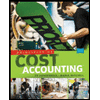
Concept explainers
(a)
Absorption Costing
Absorption costing is compulsory under Generally Accepted Accounting Principles (GAAP) for financial statements circulated to the external users. Under absorption costing, the cost of goods manufactured includes direct materials, direct labor, and factory overhead costs. Fixed factory overhead and variable factory overhead included as a part of factory overhead.
Variable Costing
Managers frequently use variable costing for internal purposes for taking decision making. The cost of goods manufactured includes direct materials, direct labor, and variable factory overhead. Fixed factory overhead treated as period (fixed) expense.
To Determine: The income statement according to the absorption costing concept for the Company FPF.
(a)
Answer to Problem 20.1APR
Calculate the income statement according to the absorption costing concept for the Company FPF as shown below:
| Company FPF | ||
| Absorption costing income statement for the month ended | ||
| May 31, 2016 | ||
| Particulars | $ | $ |
| Sales | 6,480,000 | |
| Less: Cost of goods sold | ||
| Cost of goods manufactured | 5,760,000 | |
| Ending inventory (2) | (576,000) | |
| Total cost of goods sold | 5,184,000 | |
| Gross profit | 1,296,000 | |
| Less: Selling and administrative expenses | 936,000 | |
| Income from operations | 360,000 | |
Table (1)
Explanation of Solution
Working notes:
- 1. Calculate the value of ending inventory per unit.
2. Calculate the value of ending inventory
Therefore, income from operations under absorption costing concept of Company FPF is $360,000.
(b)
The income statement according to the variable cost concept for the Company FPF.
(b)
Answer to Problem 20.1APR
Calculate the income statement according to the variable costing concept for the Company FPF as shown below:
| Company FPF | ||
| Variable costing income statement for the month ended | ||
| May 31, 2016 | ||
| Particulars | $ | $ |
| Sales | 6,480,000 | |
| Less: Variable cost of goods sold | ||
| Variable cost of goods manufactured (3) | 5,200,000 | |
| Ending inventory (5) | (520,000) | |
| Total variable cost of goods sold | 4,680,000 | |
| Manufacturing margin | 1,800,000 | |
| Less: Variable selling and administrative expenses | 648,000 | |
| Contribution margin | 1,152,000 | |
| Less: Fixed costs | ||
| Fixed manufacturing costs | 560,000 | |
| Fixed selling and administrative expenses | 288,000 | |
| Total fixed cost | 848,000 | |
| Income from operations | 304,000 | |
Table (2)
Explanation of Solution
Working notes:
1. Calculate cost of goods manufactured
2. Calculate the value of ending inventory per unit.
3. Calculate the value of ending inventory
Therefore, income from operations under variable costing concept of Company FPF is $304,000.
(c)
To Identify: The reason for the difference between in the amount of income from operations reported in absorption costing income statement and variable costing income statement.
(c)
Explanation of Solution
The difference between the absorption and variable costing income from operations of $56,000
Increase in inventory = 4,000 units
Fixed factory overhead per unit = $14
Under absorption costing method, the fixed
Under variable costing, all of the fixed factory overhead cost is subtracted in the period in which it is incurred, regardless of the amount of inventory change. Therefore, when inventory rises, the absorption costing income statement will have a higher income from operations than will the variable costing income statement.
Want to see more full solutions like this?
Chapter 20 Solutions
CENGAGENOWV2 FOR WARREN'S FINANCIAL & M
- I need help with this general accounting problem using proper accounting guidelines.arrow_forwardNeed help with this question solution general accountingarrow_forwardCompare the cost model vs. revaluation model, including pros, cons, and theoretical implications (e.g., relevance vs. reliability).arrow_forward
- General accounting questionarrow_forwardI am looking for the correct answer to this general accounting problem using valid accounting standards.arrow_forwardIf the project's cost of capital is 11%, what is the NPV of the project? What is the Year-0 net cash flow? $ -85,000 What are the net operating cash flows in Years 1, 2, and 3? Year 1: $25,403 Year 2: $27,682 Year 3: $21,606arrow_forward
- I am searching for the correct answer to this general accounting problem with proper accounting rules.arrow_forwardPlease explain the solution to this general accounting problem with accurate explanations.arrow_forwardI need help with this general accounting question using standard accounting techniques.arrow_forward
 Managerial Accounting: The Cornerstone of Busines...AccountingISBN:9781337115773Author:Maryanne M. Mowen, Don R. Hansen, Dan L. HeitgerPublisher:Cengage Learning
Managerial Accounting: The Cornerstone of Busines...AccountingISBN:9781337115773Author:Maryanne M. Mowen, Don R. Hansen, Dan L. HeitgerPublisher:Cengage Learning Managerial AccountingAccountingISBN:9781337912020Author:Carl Warren, Ph.d. Cma William B. TaylerPublisher:South-Western College Pub
Managerial AccountingAccountingISBN:9781337912020Author:Carl Warren, Ph.d. Cma William B. TaylerPublisher:South-Western College Pub Cornerstones of Cost Management (Cornerstones Ser...AccountingISBN:9781305970663Author:Don R. Hansen, Maryanne M. MowenPublisher:Cengage Learning
Cornerstones of Cost Management (Cornerstones Ser...AccountingISBN:9781305970663Author:Don R. Hansen, Maryanne M. MowenPublisher:Cengage Learning- Principles of Accounting Volume 2AccountingISBN:9781947172609Author:OpenStaxPublisher:OpenStax College
 Financial And Managerial AccountingAccountingISBN:9781337902663Author:WARREN, Carl S.Publisher:Cengage Learning,
Financial And Managerial AccountingAccountingISBN:9781337902663Author:WARREN, Carl S.Publisher:Cengage Learning, Principles of Cost AccountingAccountingISBN:9781305087408Author:Edward J. Vanderbeck, Maria R. MitchellPublisher:Cengage Learning
Principles of Cost AccountingAccountingISBN:9781305087408Author:Edward J. Vanderbeck, Maria R. MitchellPublisher:Cengage Learning





